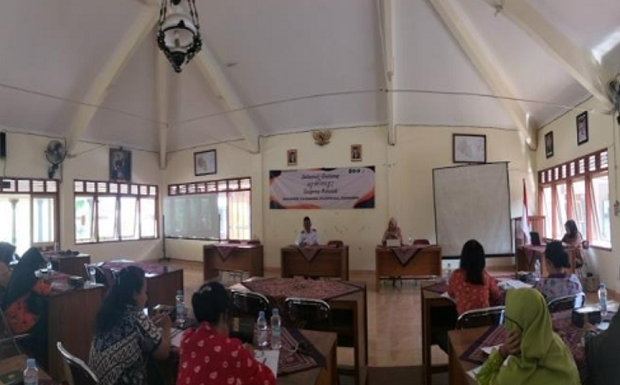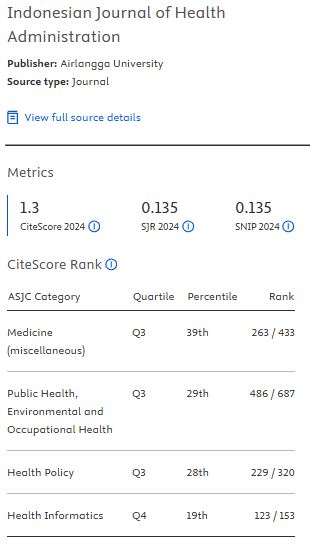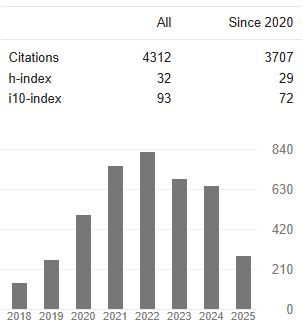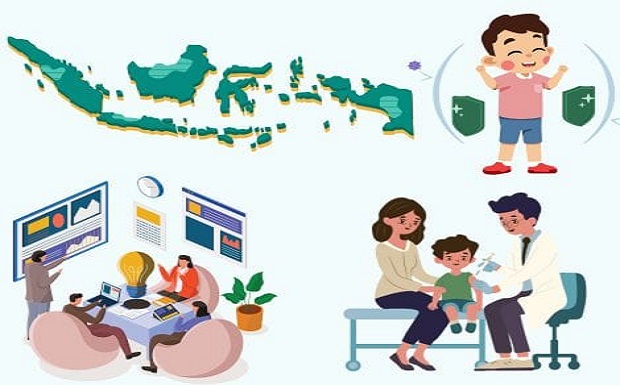ASSESSING POSYANDU CADRES’ READINESS IN IMPLEMENTING INTEGRATED PRIMARY HEALTH SERVICES IN YOGYAKARTA, INDONESIA

Downloads
Background: The readiness of Posyandu (a community-based health service) cadres’ to implement the Integrated Primary Health Services (Integrasi Layanan Primer/ILP) is vital to advancing preventive and promotive care.
Aims: This study aims to evaluate the cadres’ readiness, identify challenges, and propose effective strategies for sustainable implementation.
Methods: A mixed-method design from April to June 2024. 113 cadres from Kulon Progo, Sleman, and Yogyakarta City participated in a cross-sectional study. Cadres' readiness was evaluated based on the posyandu cadres’ basic skills training curriculum. Ten informants were interviewed to explore the opportunities, needs, and limitations of the ILP implementation. Descriptive statistics were used for data analysis.
Results: Most cadres (63.7%) were aged 41–50 years, 60.2% had completed senior high school, and 72.6% were housewives. The cadres demonstrated high readiness for ILP implementation, with the main needs in the form of improving logistics, funding, training, and community participation. In addition, there was a need to improve the literacy and skills of cadres in providing health services across the life stages, such as immunization, growth and development monitoring, and infant and child feeding.
Conclusion:Posyandu cadres are ready to implement the ILP; however, strengthening cadres’ capacity and fostering community collaboration are key strategies for ensuring the sustainability of the program and achieving health transformation.
Keywords: cadres, health transformation, integrated primary service, posyandu
Amahmid, O. et al. (2020) ‘Nutrition education in school curriculum: impact on adolescents’ attitudes and dietary behaviours’, International Journal of Health Promotion and Education, 58(5), pp. 242–258. Available at: https://doi.org/10.1080/14635240.2019.1685399.
Atika, N. (2023) ‘Several Pillars of Health Transformation in Indonesia: From Resilience Pharmaceutical Supply, Health Insurance, Primary Health Care, to Digital Health’, Indonesian Journal of Health Administration, 11(2), pp. 183–185. Available at: https://doi.org/10.20473/jaki.v11i2.2023.183-185.
Barry, M.M. (2021) ‘Transformative health promotion: what is needed to advance progress?’, Global Health Promotion, 28(4), pp. 8–16. Available at: https://doi.org/10.1177/17579759211013766.
Biset, G. et al. (2021) ‘Full immunization coverage and associated factors among children age 12-23 months in Ethiopia: systematic review and meta-analysis of observational studies’, Human Vaccines & Immunotherapeutics, 17(7), pp. 2326–2335. Available at: https://doi.org/10.1080/21645515.2020.1870392.
Carter, N. et al. (2014) ‘The Use of Triangulation in Qualitative Research’, Oncology Nursing Forum, 41(5), pp. 545–547. Available at: https://doi.org/10.1188/14.ONF.545-547.
Darmawati, D. et al. (2022) ‘Explorando las perspectivas de las madres indonesias sobre la anemia durante el embarazo: un enfoque cualitativo’, Enfermería Clínica, 32, pp. S31–S37. Available at: https://doi.org/10.1016/j.enfcli.2020.11.002.
Desta, M. et al. (2021) ‘Is preterm birth associated with intimate partner violence and maternal malnutrition during pregnancy in Ethiopia? A systematic review and meta analysis’, Heliyon, 7(10), p. e08103. Available at: https://doi.org/10.1016/j.heliyon.2021.e08103.
Follong, B.M. et al. (2022) ‘Nutrition across the curriculum: a scoping review exploring the integration of nutrition education within primary schools’, Nutrition Research Reviews, 35(2), pp. 181–196. Available at: https://doi.org/10.1017/S0954422421000111.
Harrison, R. et al. (2021) ‘Where Do Models for Change Management, Improvement and Implementation Meet? A Systematic Review of the Applications of Change Management Models in Healthcare’, Journal of Healthcare Leadership, Volume 13, pp. 85–108. Available at: https://doi.org/10.2147/JHL.S289176.
Heydarian, M. et al. (2021) ‘Effect of COVID-19 on the Number of CT-scans and MRI Services of Public Hospitals in Iran: An Interrupted Time Series Analysis’, Ethiopian Journal of Health Sciences, 31(6), pp. 1109–1114. Available at: https://doi.org/10.4314/ejhs.v31i6.5.
Huda, N. et al. (2020) ‘Family Planning Village Program in Response to the Use of Long-Term Contraceptive Method’, Indonesian Journal of Health Administration (Jurnal Administrasi Kesehatan Indonesia), 8(1), pp. 78–89. Available at: https://doi.org/10.20473/jaki.v8i1.2020.78-89.
İlgün, G., Konca, M. and Sönmez, S. (2023) ‘The Relationship Between the Health Transformation Program and Health Expenditures: Evidence From an Autoregressive Distributed Lag Testing Approach’, Value in Health Regional Issues, 38, pp. 101–108. Available at: https://doi.org/10.1016/j.vhri.2023.08.003.
Indonesian Ministry of Health (2023) Kurikulum Pelatihan Keterampilan Dasar bagi Kader Posyandu. 1st edn. Jakarta: Indonesian Ministry of Health.
Karoli, P. et al. (2024) ‘Mid-level healthcare workers knowledge on non-communicable diseases in Tanzania: a district-level pre-and post-training assessment’, BMC Health Services Research, 24(1), p. 612. Available at: https://doi.org/10.1186/s12913-024-11078-w.
Keith, R.E. et al. (2017) ‘Using the Consolidated Framework for Implementation Research (CFIR) to produce actionable findings: a rapid-cycle evaluation approach to improving implementation’, Implementation Science, 12(1), p. 15. Available at: https://doi.org/10.1186/s13012-017-0550-7.
Kong, X. et al. (2015) ‘Overview of the health care system in Hong Kong and its referential significance to mainland China’, Journal of the Chinese Medical Association, 78(10), pp. 569–573. Available at: https://doi.org/10.1016/j.jcma.2015.02.006.
Marlita, C.Y. et al. (2021) ‘The roles of Health Cadres in the Implementation of Mental Health Programs in Indonesia’, International Journal of Nursing Education, 14(1), pp. 9–18. Available at: https://doi.org/10.37506/ijone.v14i1.17730.
Pari-Keener, M. et al. (2020) ‘Maternal and Infant Health Outcomes Associated with Medical Nutrition Therapy by Registered Dietitian Nutritionists in Pregnant Women with Malnutrition: An Evidence Analysis Center Systematic Review’, Journal of the Academy of Nutrition and Dietetics, 120(10), pp. 1730–1744. Available at: https://doi.org/10.1016/j.jand.2019.10.024.
Pringle, J. et al. (2019) ‘Developing a taxonomy to characterise trusted adult support in the lives of adolescents’, Journal of Adolescence, 76(1), pp. 30–36. Available at: https://doi.org/10.1016/j.adolescence.2019.08.004.
Salvador-Carulla, L. et al. (2024) ‘Adaptation of the technology readiness levels for impact assessment in implementation sciences: The TRL-IS checklist’, Heliyon, 10(9), p. e29930. Available at: https://doi.org/10.1016/j.heliyon.2024.e29930.
Saran, M. et al. (2023) ‘The impact of the Iranian health transformation plan policy on equitable access to medical imaging services in West Iran’, BMC Research Notes, 16(1), p. 350. Available at: https://doi.org/10.1186/s13104-023-06634-2.
Scanteianu, A. et al. (2022) ‘The availability of contraceptives is everywhere: coordinated and integrated public family planning service delivery in Rwanda’, Reproductive Health, 19(1), p. 22. Available at: https://doi.org/10.1186/s12978-022-01325-w.
Siswati, T., Iskandar, S., et al. (2022) ‘Effect of a Short Course on Improving the Cadres’ Knowledge in the Context of Reducing Stunting through Home Visits in Yogyakarta, Indonesia’, International Journal of Environmental Research and Public Health, 19(16), p. 9843. Available at: https://doi.org/10.3390/ijerph19169843.
Siswati, T., Olfah, Y., et al. (2022) ‘Improving Adolescent Knowledge and Attitude toward the Intergenerational Cycle of Undernutrition through Audiovisual Education: Findings from RESEPIN Study in Yogyakarta, Indonesia’, Indian Journal of Community Medicine, 47(2), pp. 196–201. Available at: https://doi.org/10.4103/ijcm.ijcm_1229_21.
Suryanto, Plummer, V. and Boyle, M. (2017) ‘Healthcare System in Indonesia’, Hospital Topics, 95(4), pp. 82–89. Available at: https://doi.org/10.1080/00185868.2017.1333806.
Tan, C.C. et al. (2021) ‘Singapore’s health-care system: key features, challenges, and shifts’, The Lancet, 398(10305), pp. 1091–1104. Available at: https://doi.org/10.1016/S0140-6736(21)00252-X.
Tang, Y. et al. (2022) ‘The effect of peer education based on adolescent health education on the resilience of children and adolescents: A cluster randomized controlled trial’, PLOS ONE. Edited by E. Kabir, 17(2), p. e0263012. Available at: https://doi.org/10.1371/journal.pone.0263012.
Tong, A., Sainsbury, P. and Craig, J. (2007) ‘Consolidated criteria for reporting qualitative research (COREQ): a 32-item checklist for interviews and focus groups’, International Journal for Quality in Health Care, 19(6), pp. 349–357. Available at: https://doi.org/10.1093/intqhc/mzm042.
Trankle, S.A. et al. (2019) ‘Integrating health care in Australia: a qualitative evaluation’, BMC Health Services Research, 19(1), p. 954. Available at: https://doi.org/10.1186/s12913-019-4780-z.
Wibowo, Y. et al. (2021) ‘A pilot study of cadre training to promote responsible self‐medication in Indonesia: Which is better specific or general modules?’, Health & Social Care in the Community, 29(2), pp. 554–563. Available at: https://doi.org/10.1111/hsc.13118.
World Health Organization (2010) ‘Monitoring the building blocks of health systems: a handbook of indicators and their measurement strategies’, p. 92.
Yani, F. et al. (2023) ‘Access and utilization of health services improved by trained posyandu cadres in rural Indonesia’, European Journal of Public Health, 33(Supplement_2), p. ckad160.805. Available at: https://doi.org/10.1093/eurpub/ckad160.805.
Young, M.F. and Ramakrishnan, U. (2020) ‘Maternal Undernutrition before and during Pregnancy and Offspring Health and Development’, Annals of Nutrition and Metabolism, 76(Suppl. 3), pp. 41–53. Available at: https://doi.org/10.1159/000510595.
Copyright (c) 2025 Tri Siswati, Yustiana Olfah, Jutharat Attawet, Nurhidayat Nurhidayat, Lukman Waris

This work is licensed under a Creative Commons Attribution-ShareAlike 4.0 International License.
1. As an author you (or your employer or institution) may do the following:
- make copies (print or electronic) of the article for your own personal use, including for your own classroom teaching use;
- make copies and distribute such copies (including through e-mail) of the article to research colleagues, for the personal use by such colleagues (but not commercially or systematically, e.g. via an e-mail list or list server);
- present the article at a meeting or conference and to distribute copies of the article to the delegates attending such meeting;
- for your employer, if the article is a ‘work for hire', made within the scope of your employment, your employer may use all or part of the information in the article for other intra-company use (e.g. training);
- retain patent and trademark rights and rights to any process, procedure, or article of manufacture described in the article;
- include the article in full or in part in a thesis or dissertation (provided that this is not to be published commercially);
- use the article or any part thereof in a printed compilation of your works, such as collected writings or lecture notes (subsequent to publication of the article in the journal); and prepare other derivative works, to extend the article into book-length form, or to otherwise re-use portions or excerpts in other works, with full acknowledgement of its original publication in the journal;
- may reproduce or authorize others to reproduce the article, material extracted from the article, or derivative works for the author's personal use or for company use, provided that the source and the copyright notice are indicated.
All copies, print or electronic, or other use of the paper or article must include the appropriate bibliographic citation for the article's publication in the journal.
2. Requests from third parties
Although authors are permitted to re-use all or portions of the article in other works, this does not include granting third-party requests for reprinting, republishing, or other types of re-use.
3. Author Online Use
- Personal Servers. Authors and/or their employers shall have the right to post the accepted version of articles pre-print version of the article, or revised personal version of the final text of the article (to reflect changes made in the peer review and editing process) on their own personal servers or the servers of their institutions or employers without permission from JAKI;
- Classroom or Internal Training Use. An author is expressly permitted to post any portion of the accepted version of his/her own articles on the author's personal web site or the servers of the author's institution or company in connection with the author's teaching, training, or work responsibilities, provided that the appropriate copyright, credit, and reuse notices appear prominently with the posted material. Examples of permitted uses are lecture materials, course packs, e-reserves, conference presentations, or in-house training courses;























